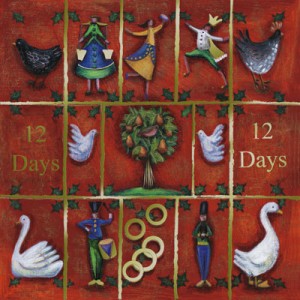 The "Twelve Days of Christmas" refer to the eight days of the Christmas Octave from December 25 to New Years Day, and the five additional days up to and including January 6, the traditional date for the Feast of the Epiphany. In the USA and many other countries, Epiphany is now celebrated on the first Sunday after New Years, so the exact number 12 does not necessarily apply. But the point is, don't throw out the tree on the 26th--the birth of the Savior can't be celebrated adequately in one day. Let the celebration continue through at least through the Feast of the Epiphany--if not through the Feast of the Baptism of the Lord.
The "Twelve Days of Christmas" refer to the eight days of the Christmas Octave from December 25 to New Years Day, and the five additional days up to and including January 6, the traditional date for the Feast of the Epiphany. In the USA and many other countries, Epiphany is now celebrated on the first Sunday after New Years, so the exact number 12 does not necessarily apply. But the point is, don't throw out the tree on the 26th--the birth of the Savior can't be celebrated adequately in one day. Let the celebration continue through at least through the Feast of the Epiphany--if not through the Feast of the Baptism of the Lord.
According to A Handbook of Catholic Sacramentals![]() by Ann Ball, the famous song about the 12 Days of Christmas was written in England as a catechism song for young Catholics in the days when it was illegal to practice or teach the Catholic Faith. It contains hidden meanings intended to help children remember lessons of faith. Instead of referring to an earthly suitor, the "true love" mentioned in the song really refers to God. The "me" who receives the presents is symbolic of every baptized person.
by Ann Ball, the famous song about the 12 Days of Christmas was written in England as a catechism song for young Catholics in the days when it was illegal to practice or teach the Catholic Faith. It contains hidden meanings intended to help children remember lessons of faith. Instead of referring to an earthly suitor, the "true love" mentioned in the song really refers to God. The "me" who receives the presents is symbolic of every baptized person.
Partridge in a pear tree - Jesus Christ, symbolized as a mother partridge that feigns injury to decoy predators from helpless nestlings.
Two turtle doves - Old & New Testaments
Three French Hens - Faith, hope, charity
Four Calling birds - The Four Gospels
Five Golden Rings - The Pentateuch or Five Books of Moses (Genesis through Deuteronomy)
Six geese a laying - Six days of creation
Seven Swans a swimming - 7 Gifts of the Holy Spirit
Eight maids a-milking - 8 Beatitudes
Nine Ladies Dancing - Nine Fruits of the Holy Spirit
Ten Lords a-leaping - 10 Commandments
Eleven pipers piping - The 11 faithful disciples
12 drummers drumming - 12 articles of the Apostles Creed
This article originally appeared at www.crossroadsinitiative.com and is reproduced here by permission of the author. For additional articles by Dr, Marcellino D'Ambrosio visit his website at www.crossroadsinitiative.com
About the Author

Guest
We welcome guest contributors who graciously volunteer their writing for our readers. Please support our guest writers by visiting their sites, purchasing their work, and leaving comments to thank them for sharing their gifts here on CatholicMom.com. To inquire about serving as a guest contributor, contact editor@CatholicMom.com.


.png?width=1806&height=731&name=CatholicMom_hcfm_logo1_pos_871c_2728c%20(002).png)
Comments